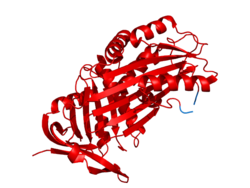Top Qs
Timeline
Chat
Perspective
Transcortin
Protein found in humans From Wikipedia, the free encyclopedia
Remove ads
Transcortin, also known as corticosteroid-binding globulin (CBG) or serpin A6, is a protein produced in the liver in animals. In humans it is encoded by the SERPINA6 gene. It is an alpha-globulin.[5][6][7]
Remove ads
Function
This gene encodes an alpha-globulin protein with corticosteroid-binding properties. This is the major transport protein for glucocorticoids and progestins in the blood of most vertebrates. The gene localizes to a chromosomal region containing several closely related serine protease inhibitors (serpins).[7]
Binding
Transcortin binds several steroid hormones at high rates:
- Cortisol - Approximately 90% of the cortisol in circulation is bound to transcortin. (The rest is bound to serum albumin.) Cortisol is thought to be biologically active only when it is not bound to transcortin.[citation needed]
- Cortisone[8]
- Deoxycorticosterone (DOC)[8]
- Corticosterone - About 78% of serum corticosterone is bound to transcortin.
- Aldosterone - Approximately 17% of serum aldosterone is bound to transcortin, while another 47% is bound to serum albumin. The remaining 36% is free.[9]
- Progesterone - Approximately 18% of serum progesterone is bound to transcortin, while another 80% of it is bound to serum albumin. The remaining 2% is free.[10]
- 17α-Hydroxyprogesterone[8]
In addition, approximately 4% of serum testosterone is bound to transcortin.[11] A similarly small fraction of serum estradiol is bound to transcortin as well.[citation needed]
Remove ads
Synthesis
Transcortin is produced by the liver and is increased by estrogens.[12]
Clinical significance
Mutations in this gene are rare. Only four mutations have been described, often in association with fatigue and chronic pain.[13] The mechanism for these symptoms is not known. This condition must be distinguished from secondary hypocortisolism. Exogenous hydrocortisone does not appear to improve the fatigue.[citation needed]
Hepatic synthesis of corticosteroid-binding globulin more than doubles in pregnancy; that is, bound plasma cortisol in term pregnancy is approximately 2 to 3 times that of nonpregnant women.[14][15]
Remove ads
See also
- Serpin
- Circaseptan, 7-day biological cycle
References
Further reading
External links
Wikiwand - on
Seamless Wikipedia browsing. On steroids.
Remove ads






